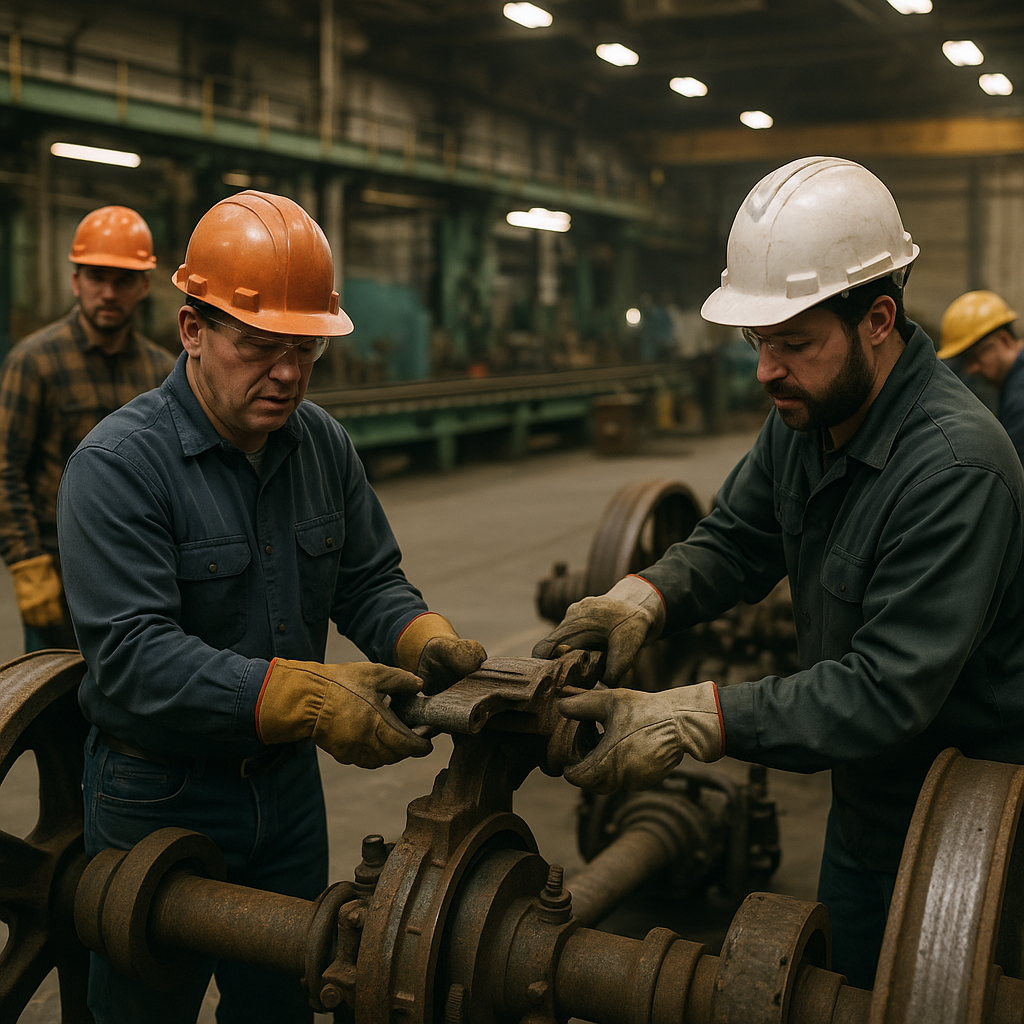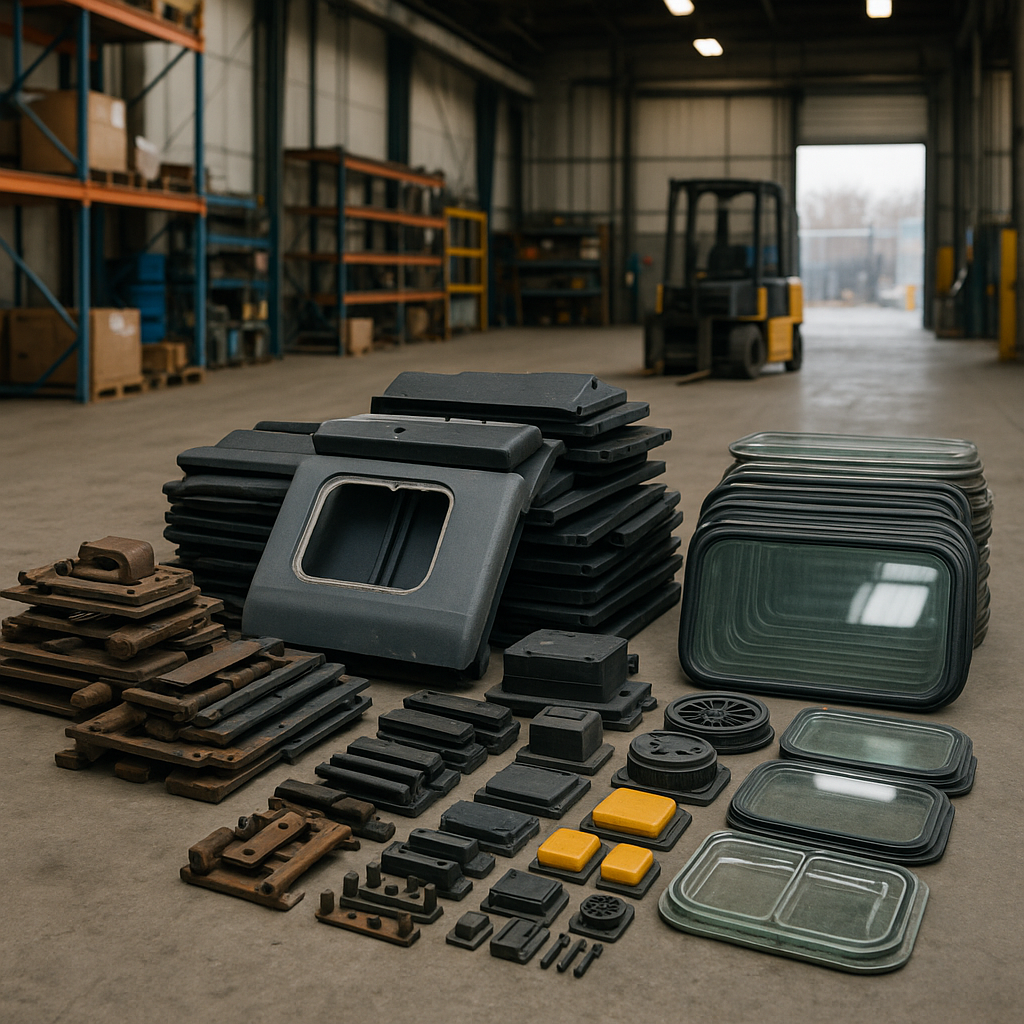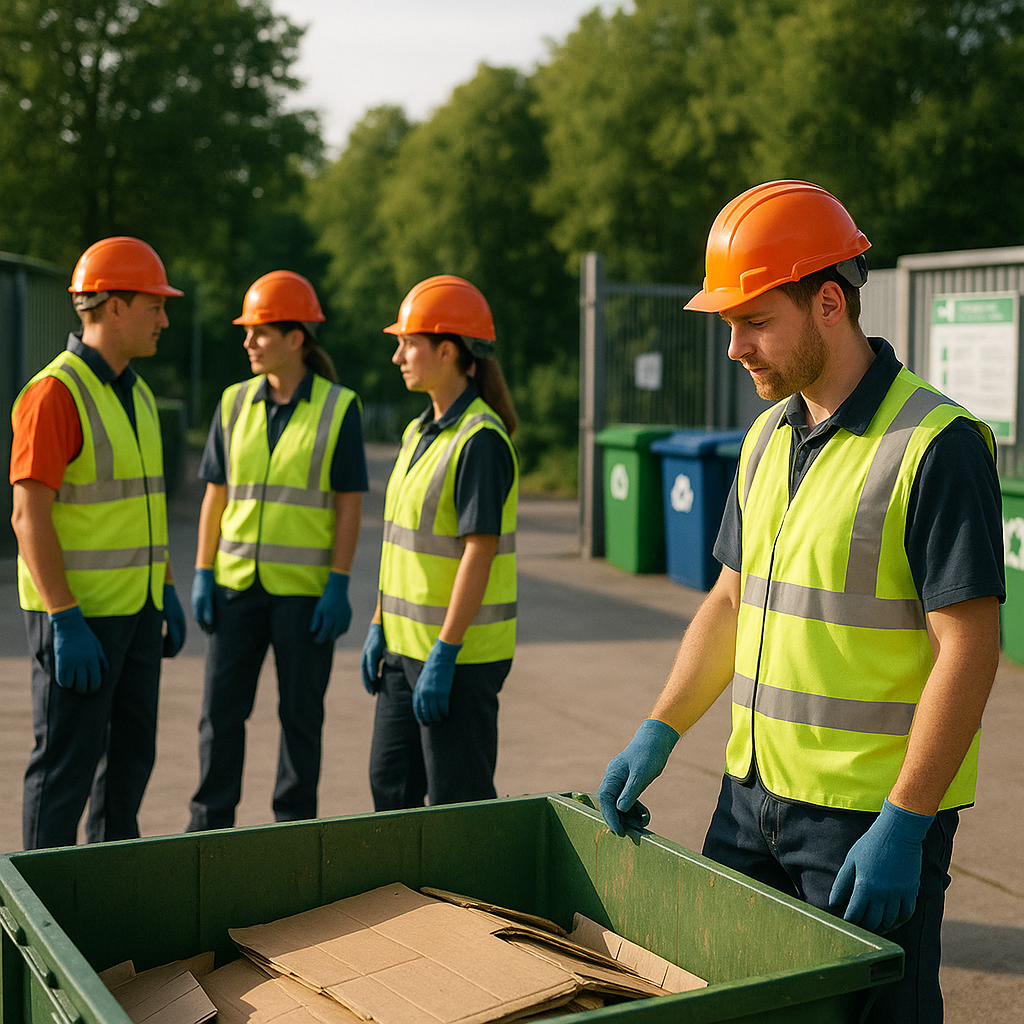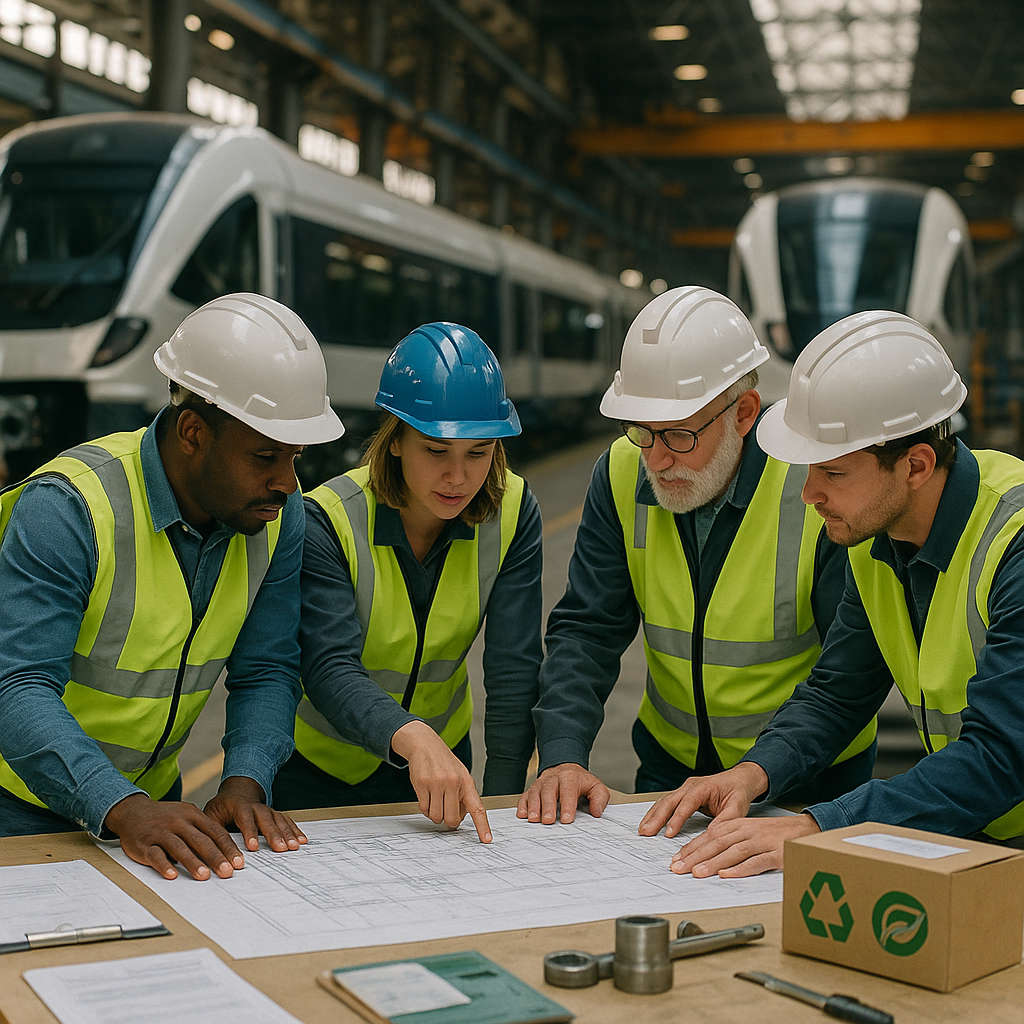5901 Botham Jean Blvd, Dallas, TX 75215
A Quick Guide to Recycling Train Engines and Parts?
June 18, 2025Did you know a single locomotive contains enough steel to build over 100 cars? This impressive fact underscores the importance of train recycling for environmental sustainability. The vast amount of recoverable materials makes rail equipment one of the most valuable sources of recyclable metals in our transportation infrastructure.
Recycling train engines and parts involves carefully dismantling train cars and locomotives to extract reusable materials. This systematic process includes specific stages: pre-treatment, dismantling, and shredding. During pre-treatment, technicians remove hazardous materials like oils, fire extinguishers, and batteries. The dismantling stage extracts valuable components such as wheel sets, bogies, electronics, and copper wiring.
Train component recycling encompasses everything from metal parts to seat covers. Steel and aluminum comprise over 90% of a train’s weight, making these materials highly prized in recycling markets. A single mile of railroad track can yield approximately 90 tons of recyclable steel. This recovery process significantly reduces the need for new material extraction and manufacturing.
How Does the Train Component Recycling Process Work?

The train component recycling process is a systematic approach that maximizes resource recovery while ensuring environmental safety. This process occurs in three main stages: pre-treatment, dismantling, and shredding, each serving a specific purpose in the recycling chain for efficient material recovery.
Pre-Treatment Stage
The initial phase focuses on making the train safe for further processing. Technicians drain all working fluids, such as oils, brake fluids, and antifreeze, into separate containers for specialized processing, requiring careful handling.
During pre-treatment, workers also remove potentially hazardous materials to prevent contamination. Fire extinguishers, batteries, capacitors, brake sand, and other harmful components are extracted and sent to specialized facilities. This step ensures workplace safety during subsequent recycling phases and prevents environmental contamination.
Dismantling Stage
The second phase involves the strategic removal of valuable components suitable for recycling or reuse. Workers extract major recyclable parts such as wheel sets, bogies, bogie frames, buffers, springs, couplings, and brake systems. These components are assessed to determine whether they can be reused directly or require refurbishment.
Additional elements removed during this stage include glazing, electronics, seats, floors, and door systems. Most modern train cars feature designs that simplify dismantling with clearly marked materials and accessible connections. The components extracted are sorted and sent to specialized recycling facilities appropriate for each material type.
For passenger coaches, this process typically recovers about 75% of recyclable materials, while freight cars can yield up to 95% recyclable content. The dismantling stage is crucial for maximizing the recovery of valuable materials.
Shredding Stage
After extracting all recyclable parts, workers send the remaining train structure to an industrial shredder. This equipment breaks down the vehicle into small fragments that sorters can easily separate, effectively sorting different materials based on their properties.
Metal sorting happens during this stage through various mechanical processes. Magnetic separation extracts ferrous metals like steel, while eddy current and density-based sorting systems recover non-ferrous metals such as aluminum and copper. The metal recovery rate is impressive, with approximately 68% of a train’s total mass typically consisting of recyclable metals recovered during shredding.
The remaining shredder residue includes plastics, textiles, and other materials. Modern facilities can recover up to 67% of this shredder residue for recycling or energy recovery, though capabilities vary by location and available technology.
Material Recovery Outcomes
Through these three stages, the train component recycling process achieves remarkable efficiency. Modern train designs can reach recovery rates of up to 97%. Ferrous metals like steel and cast iron have recovery rates between 90-98%, making them highly recyclable. Non-ferrous metals such as aluminum, copper, lead, and zinc can achieve recovery rates of 60-95%.
Glass components, particularly windows and safety glass, can be recycled at rates of 50-100% through specialized remelting processes. Liquids from trains are collected during the pre-treatment phase and can be refined or used for energy recovery with recycling rates of 50-100%.
As train manufacturers increasingly incorporate recyclability into their designs, the recovery rates continue to improve. Companies like Alstom, Siemens, CRRC, and others now regularly promote the recyclability percentages of their new train models, highlighting the industry’s growing commitment to sustainability.
| Type of Material | Recovery Rate for Calculation | Practical Recovery Rate | Recovery Method |
|---|---|---|---|
| Ferrous metals – Steel | 98% | 90–98% | Shredding and remelting |
| Ferrous metals – Cast iron | 98% | 80–90% | Shredding and remelting |
| Non-ferrous metals – Lead | 98% | 80–98% | Dismantling, mechanical separation and remelting |
| Non-ferrous metals – Aluminum | 98% | 80–95% | Dismantling, mechanical separation and remelting |
| Non-ferrous metals – Copper, Zinc | 98% | 60–80% | Dismantling, mechanical separation and remelting |
| Polymers (excluding elastomers) | 100% | 50–70% | Dismantling, separation and recycling processes |
| Elastomers | 100% | 50–70% | Dedicated recycling processes |
| Glass | 100% | 50–100% | Remelting |
| Safety glass | 94% | 50–94% | Separation and remelting |
| Oils | 100% | 50–100% | Refining, Incineration |
| Other fluids | 83% | 50–80% | Dedicated recycling processes |
| Modified organic natural materials | 100% | 50–70% | Shredder light fraction recycling |
| Carbon reinforced polymers | 80% | 50–70% | Dedicated recycling processes |
| Electronic and electric | 98% | 60–85% | Sorting and dedicated recycling processes |
What Materials Can Be Recycled from Trains?

Trains contain a diverse range of recyclable materials, making them excellent candidates for comprehensive recycling programs. Metals are the most abundant and valuable components, comprising over 90% of a train’s total weight. Steel and aluminum form much of a train’s structure, including the carbody, bogies, and framework.
Ferrous metals like steel and cast iron achieve recovery rates between 90-98% through magnetic separation techniques. Non-ferrous metals such as aluminum, copper, lead, and zinc can reach recovery rates of 60-95% through dismantling, mechanical separation, and remelting processes. This high metal content creates significant recycling value.
Glass components, particularly windows and safety glass, can be recycled at rates of 50-100% through specialized remelting processes. These materials require careful separation from frames and other attachments to maintain quality during recycling.
Liquids from trains, including oils and lubricants, are collected during the pre-treatment phase and can achieve recycling rates of 50-100%. These fluids are drained into separate containers and sent to specialized facilities for proper handling or energy recovery.
Modified organic natural materials found in trains include wood, leather, cotton, and cardboard. These materials have recycling potential of 50-70% through various processing methods. Seats, interior panels, and flooring often contain these recoverable natural fibers.
Polymers and elastomers represent another significant recyclable category with recovery rates between 50-70%. These can be processed through dismantling, separation, dedicated recycling processes, or shredder light fraction recycling.
Electronic and electrical components from train systems can be recovered at rates of 60-85% through sorting and specialized recycling processes. These components require careful handling to extract valuable materials while properly managing hazardous substances.
Recycling Challenges
Despite high recycling potential for many materials, certain components present significant challenges. Composite materials, particularly carbon fiber reinforced polymers and glass fiber reinforced polymers, lack economically efficient recycling technologies. These advanced materials are increasingly used in modern trains but pose recycling difficulties.
Plastic components also present recycling challenges due to their varied chemical compositions. Different types of plastics cannot be mixed during recycling as they have different melting temperatures and mechanical properties. This variety complicates the sorting and processing required for effective recycling.
Complex materials with multiple layers or combinations of different substances often end up as shredder residue. While approximately 50% of this residue contains combustible fractions suitable for energy recovery, the remainder typically requires landfill disposal.
The recyclability of train components varies by vehicle type. For example, passenger coaches yield about 75% recyclable materials by weight, while freight cars can reach up to 95% recyclability. Modern manufacturers now design trains with end-of-life considerations in mind, with leading companies achieving overall recyclability rates of 95-98%.
| Material Type | Components | Recyclability Rate (%) |
|---|---|---|
| Ferrous Metals | Steel frame, cast iron, wheel sets | 90-98% |
| Non-ferrous Metals | Aluminum, copper, lead, zinc | 60-95% |
| Glass | Windows, safety glass | 50-100% |
| Liquids | Oils, lubricants, brake fluids | 50-100% |
| Organic Materials | Wood, leather, cotton, cardboard | 50-70% |
| Polymers & Elastomers | Plastic components, rubber | 50-70% |
| Electronic Components | Wiring, control systems | 60-85% |
| Composite Materials | Carbon fiber, glass fiber reinforced polymers | Limited recyclability |
What are the Benefits of Train Component Recycling Programs?

Train component recycling programs offer substantial environmental benefits through several pathways. These initiatives significantly reduce landfill waste, as poorly managed end-of-life trains can generate waste equivalent to about 20 passenger vehicles. With proper recycling protocols, nearly 97% of train materials can be successfully recovered.
These programs conserve valuable resources by reusing existing materials. A single mile of railroad track yields roughly 90 tons of recyclable steel, eliminating the need for extensive mining and raw material extraction for new production.
Reducing carbon emissions is another crucial environmental advantage. The recycling process generates significantly fewer greenhouse gases compared to producing metals from virgin ore, aligning with global climate initiatives to limit temperature increases below the 1.5°C threshold established by the United Nations Framework Convention on Climate Change.
Economic Advantages
The financial benefits of train component recycling create compelling business cases for industry stakeholders. Recycling substantially reduces material purchase costs and production expenses, creating a favorable cost structure for companies investing in rail infrastructure improvements.
Steel and aluminum components, comprising over 90% of most trains by weight, offer high recyclability and economic value. The recovery of these materials helps offset decommissioning costs while supporting broader sustainability objectives.
Railway companies can generate significant revenue from recycled materials, often supporting new infrastructure investments and creating a financially sustainable cycle of resource management that benefits all industry participants.
Supporting the Circular Economy
Train component recycling programs are foundational to resource reuse systems, creating cascading environmental benefits as materials flow through multiple lifecycles, transforming waste into valuable resources.
The European Union has formalized this approach by extending ISO 22628 Recyclability standards to trains through ISO 21106. This framework promotes increasing the proportion of recyclable and reusable materials in train manufacturing. Leading manufacturers achieve impressive recycling rates of about 97% by following these guidelines.
These programs facilitate a continuous cycle where materials are recycled and reused at established rates, helping create a sustainable railway ecosystem through comprehensive resource management strategies.
Driving Innovation
Recycling initiatives spur innovation in sustainable design approaches. Manufacturers increasingly consider recyclability as a core requirement alongside traditional concerns like structural strength and operational durability, leading to more environmentally conscious product development throughout the industry.
Railway companies fulfill important social responsibilities through these programs. As industries worldwide transition toward greener operations, the railway sector demonstrates environmental leadership by addressing waste management challenges throughout the entire product lifecycle.
Cross-industry partnerships continue developing advanced recycling technologies, creating more efficient methods to process diverse materials with varying properties and recyclability requirements. Their work establishes comprehensive frameworks that support long-term sustainability goals.
| Benefit Type | Description | Impact |
|---|---|---|
| Environmental | Waste Reduction | Properly recycled trains can achieve 97% material recovery, significantly reducing landfill waste |
| Environmental | Resource Conservation | A single mile of railroad track yields approximately 90 tons of recyclable steel |
| Environmental | Carbon Emissions Reduction | Recycling generates fewer greenhouse gases compared to producing metals from virgin ore |
| Economic | Reduced Material Costs | Recycling lowers material purchase costs and production expenses for new infrastructure |
| Economic | Revenue Generation | Recovered materials create revenue streams that can fund new infrastructure investments |
| Economic | Decommissioning Cost Offset | Steel and aluminum (90% of train weight) recovery helps offset end-of-life costs |
| Circular Economy | Resource Reuse Systems | Materials flow through multiple lifecycles, transforming waste into valuable resources |
| Innovation | Sustainable Design | Manufacturers now consider recyclability alongside strength and durability requirements |
How are Train Manufacturers Embracing Recycling and Sustainability?

Train manufacturers globally are increasingly integrating recyclability and sustainability principles into their operations. Industry leaders recognize that environmental responsibility is essential for long-term success in the transportation sector.
Hyundai Rotem, a key player in the railway industry, has pioneered a virtuous recycling ecosystem. Their engineering teams analyze carbon emissions during raw materials manufacturing and track the recyclability of components by weight and density. This approach allows them to achieve recyclability rates of approximately 97%, demonstrating their commitment to sustainable manufacturing.
European manufacturers have been particularly proactive in adopting sustainability measures. Alstom in France has set an industry benchmark by achieving approximately 97% recyclability for specific project trains. They accomplish this by following strict environmental product declaration standards and applying design principles that consider end-of-life recycling from the initial development stages.
Similarly, Siemens Mobility and Chinese manufacturer CRRC have implemented extensive recyclability programs, with most manufacturers now achieving rates between 90% and 98%. This represents a significant improvement over earlier practices when end-of-life trains were simply disposed of in landfills.
Eco-Design Approaches Transforming Train Manufacturing
Beyond recyclability rates, manufacturers are embracing comprehensive eco-design approaches that consider environmental impacts throughout a train’s lifecycle. This begins with sustainable material selection, prioritizing renewable, recyclable, or lower-impact alternatives to traditional materials.
Many manufacturers now use recycled steel or composite materials made from recycled plastics in producing railway components. These choices reduce resource consumption, minimize waste, and lower the overall carbon footprint of train manufacturing.
Energy-efficient production processes represent another crucial aspect of sustainable manufacturing. Companies are investing in energy-efficient equipment, optimizing production workflows, and utilizing renewable energy sources such as solar or wind power in their manufacturing facilities.
Waste reduction strategies follow lean manufacturing principles, with process optimization and material efficiency improvements to minimize waste during production. Additionally, manufacturers have implemented recycling programs to process scrap materials, byproducts, and end-of-life components back into the production cycle.
The adoption of eco-friendly coatings and finishes further demonstrates the industry’s commitment to sustainability. Manufacturers are selecting coatings low in volatile organic compounds and hazardous chemicals to minimize air and water pollution. Alternative coating technologies like powder coating, water-based coatings, and UV-curable coatings are replacing traditional solvent-based options.
Life cycle assessment (LCA) has become a standard practice for evaluating environmental impacts from raw material extraction to end-of-life disposal. This allows manufacturers to identify improvement opportunities and implement measures to reduce environmental impacts at every stage of the product lifecycle.
In Europe, the Union des Industries Ferroviaires Européennes (UNIFE) has established guidelines on Train Recycling and Regeneration Rate Calculation Method based on ISO standards. The European Union extended these standards in 2019, promoting increased use of recyclable and reusable materials in trains through ISO 21106.
| Manufacturer | Recyclability Rate | Notable Models |
|---|---|---|
| Alstom | 97-98% | Avelia Horizon high-speed trains, Metropolis metro trains |
| Siemens Mobility | 97% | C2 metro trains for Munich |
| CRRC | Up to 94% | Nanhu low-floor tram (90%) |
| Stadler | 97% | Various Models |
| CAF | 90.8-93.6% | Various Models |
| Transmashholding (TMH) | 98% | Various Models |
| Sinara – Transport Machines | 98% | Various Models |
These collective efforts by train manufacturers represent a significant shift toward sustainable manufacturing practices. By prioritizing recyclability, adopting eco-design principles, and implementing comprehensive lifecycle management, the industry is reducing environmental impact while creating more efficient and sustainable transportation options for the future.
Conclusion: The Future of Train Component Recycling
Train component recycling is at the forefront of the railway industry’s sustainability efforts. Research suggests that recycling rates for mixed aluminum and steel could reach 96% by 2039. This marks a significant advancement in material recovery technology and the industry’s commitment to environmental stewardship. The transportation sector is moving toward a circular model where end-of-life trains become valuable resources rather than waste.
As railway companies adopt more sustainable practices, both environmental and economic benefits will expand across the industry. The reduced need for virgin materials, decreased landfill waste, and lower carbon emissions create a positive impact throughout the transportation ecosystem. For professional guidance on implementing effective recycling solutions for railway components and other industrial materials, contact Okon Recycling at 214-717-4083.
